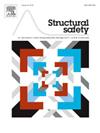Numerical algorithm for determining serviceability live loads and its applications
Abstract
The live load duration refers to the period when the live load is larger than a given threshold in the reference period. The smallest threshold that allows the duration to be shorter than the required length is employed as the design live load for serviceability limit states. However, the traditional method only considers the mean duration and the probability that the duration exceeds the required length is unknown. This study proposes a new algorithm to determine the probability distributions of the live load duration. A sustained or extraordinary load process is transformed into a random variable set based on the stochastic harmonic functions. Subsequently, the duration distributions can be derived by employing the load coincidence principle and probability density evolution method. Three numerical examples including one sustained load and multiple extraordinary loads are provided and the results of the proposed algorithm are compared with those of Monte Carlo simulation. The proposed algorithm allows the exact determination of design live loads based on a predefined exceeding probability. As an application, the quasi-permanent and frequent values of seven user categories are calculated when the exceeding probabilities are taken as 10%, 5% and 2%, respectively. It is found that the quasi-permanent values can increase with increasing area and the differences between the frequent and quasi-permanent values can be more than 20 times.

 求助内容:
求助内容: 应助结果提醒方式:
应助结果提醒方式:


